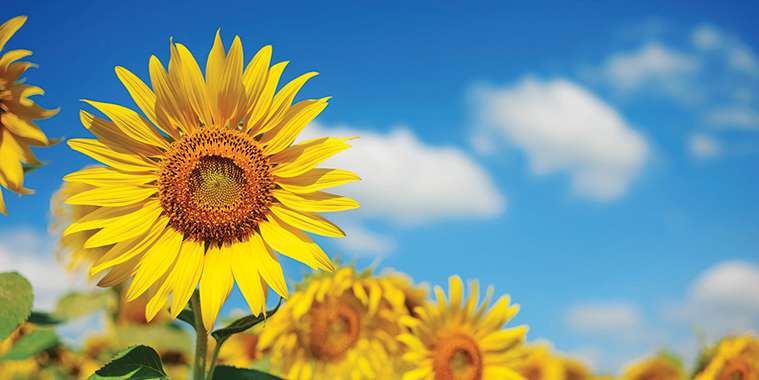This year has been declared the “Year of the Sunflower.” And with good reason! With their bright blooms that show from mid-summer to early fall, sunflowers say “summer” like no other plant.
The Sunflower is one of the most popular types of flowers to grow in your garden. First-time to experienced gardeners gravitate to these bold, easy to grow flowers.
Sunflowers originated in the Americas and domestic seeds dating back to 2100 BC have been found in Mexico. Native Americans grew sunflowers as a crop, and explorers eventually brought the flowers to Europe in the 1500s. Over the next few centuries, sunflowers became increasingly popular on the European and Asian continent, with Russian farmers growing over 2 million acres in the early 19th century (primarily for oil).
Dutch painter Vincent Van Gogh famously painted a world-renowned still-life series of sunflowers. His sunflower paintings are so famous, the Van Gogh museum has teamed up with the breeder of Sunrich sunflowers to create the “Sunrich-Van Gogh’s Favorite” label of sunflowers!
The sunflower (Helianthus annuus) is an annual plant with a large daisy-like flower face. Its scientific name comes from the Greek words helios (“sun”) and anthos (“flower”). The flowers come in many colours (yellow, red, orange, maroon, brown), but they are commonly bright yellow with brown centers that ripen into heavy heads filled with seeds. It’s a tall broad-leafed plant, usually with a single main stem and 1 head per plant. The stem is hairy and becomes very fibrous as the plant matures. Sunflowers are in full flower 70 to 80 days after planting and require about 120 days to mature.
Sunflowers are heliotropic, which means that they turn their flowers to follow the movement of the sun across the sky east to west, and then returns at night to face the east, ready again for the morning sun. Heliotropism happens during the earlier stages before the flower grows heavy with seeds. The French word for sunflower is “tournesol,” which literally means “turns with the sun.”
There are tons of varieties of sunflowers available today, so there’s bound to be one that fits your garden. Choose between those with branching stems or single stems, those that produce ample pollen for pollinators or are pollen-free (best for bouquets), those that stay small or tower above the rest of the garden, or those that produce edible seeds!
All sunflower varieties grown commercially are hybrids and based on their end use, can be classified as either oil- or confection-type sunflowers. Did you know that over 90% of Canada’s sunflowers are grown right here in Manitoba?
Approximately 60% of all Canadian sunflowers are confection-type, which are marketed primarily as roasted snack food in the shell or as dehulled seeds for the baking industry. Although a significant percentage of this market is North America, Canadian processors are increasingly accessing markets in Europe, the Middle East and Asia.
Oilseed sunflowers are used in the birdfeed and crushing industry for sunflower oil, which is one of the highest quality vegetable oils.
The birdfood market primarily uses oilseed sunflowers, however some of the smaller confection seeds are also used for birdseed.
Sunflowers grown for oil are characterized by black hulls. The non-oil or confection-type sunflowers have striped hulls and are used primarily for the human food market. Yields of confectionary sunflowers are closely tied to the quality of the seeds. Only the largest of the confection type sunflowers are used for human consumption.
While it’s too late to plant these sunny flowers this year, you can plan to plant sunflower seeds next spring right after the risk of frost has passed, or start them earlier indoors. Seeds should be sown ¼” to ½” deep and kept moist. Taller, larger sunflower varieties have a large taproot to keep them rooted and don’t do well when they are transplanted so direct sowing in the ground of those varieties is recommended. Choose a site or container in full sun with good drainage. I planted mine next to the south side of my garage and it grew past the eavestrough!
If you’re growing sunflowers for cutting, here are some recommendations to extend the vase-life of your flower:
1. Cut when the petals or ray flowers just begin to open, before they have opened off the disc completely. It’s recommended to cut in the early morning before the heat of the day.
2. Remove the leaves below the water line and place in fresh water or properly measured fresh flower food solution.
3. Check the water regularly; sunflowers are heavy drinkers and can empty a bucket or vase overnight!
4. Change the water daily; sunflowers have what some call a dirty stem, as the water quickly turns cloudy with potential for bacterial issues.
Fun facts about the sunflower
• Sunflowers are one of the most recognized flowers in the world.
• Each sunflower is actually thousands of teeny flowers. The iconic yellow petals and fuzzy brown centers are actually individual flowers themselves. As many as 2,000 can make up the classic sunflower bloom!
• You should harvest sunflowers in the morning, not the afternoon. If you cut them in the afternoon, they may wilt.
• A dried sunflower makes a unique, natural bird feeder since they love to snack on sunflower seeds just like you do!
• Each sunflower can contain as many as 1,000 to 2,000 seeds.
• There are about 70 species of sunflowers. While many varieties are cheery and yellow, their appearance can be quite different. For instance, the Ruby sunflower is a deep red colour, while the Teddybear looks like a pompom! My personal favourite is the dramatic Ring of Fire.
• Some people have a fear of sunflowers. This is called Helianthophobia. Who knew?
• The tallest sunflower on record was over 30 feet tall. Coming in at 30-feet 1-inch, the bloom was grown in Germany in 2014 by Hans-Peter Schiffer, who had held the record twice before!
• Sunflowers have been planted to help soak up nuclear radiation. They’re not just pretty, but are actually good at absorbing toxins, too. Millions were planted after the devastating tsunami destroyed reactors in the Fukushima nuclear power plant in Japan.
•Sunflower seeds travelled to space in 2012 when astronaut Don Pettit took them on board the International Space Station.
• Sunflowers symbolize optimism, positivity, long life and happiness.
Plan to stock up on your sunflower seeds early in preparation for next spring? Check out T&T Seeds right here in Manitoba at ttseeds.com or call 204-895-9962 and get them mailed directly to you.



